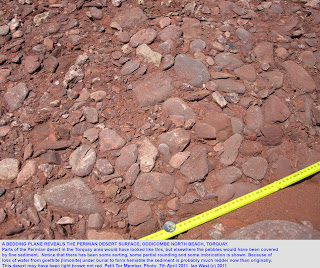The area of the Earth that we now call Britain has moved around a lot over time. The evidence for this is contained in our rocks - Britain has just about the most complicated geology of any area of its size anywhere in the world!
What the Syllabus Says - and the Details
The rocks of the Britain area provide evidence of changing latitude and climate as Britain moved northwards.
In the Lower Palaeozoic Britain was south of the equator and was involved in a major plate collision which produced the Caledonian mountain belt. We still have the 'stubs' of the mountains formed by his collision in Scotland and North Wales.
The evidence for these statements comes from...
Turbidites - these deep water sediments which are found in the west of Britain, for instance in north west Wales, show that the are we now call was Britain was then under deep water.
Granites - The granites intruded into the west of Britain during the lower Palaeozoic show that a major plate collision was occurring - these granites are typical of a collision between two continental plates. The collision was between what we now call Europe and whet we now call North America.
Significant regional metamorphism is also found throughout the west of Britain. This would also indicate a plate collision. The region also contains thrusts and folds which would have been caused by that plate collision.
We know where the boundary between the two plates occurred as the fossils to the north and south of the line show very different lines of evolution.
In the Upper Palaeozoic - Britain drifted across the equator.
We can track the periods of geological time in Britain from the conditions seen in the rocks from each one.
At the start of the Upper Palaeozoic, the Devonian period, Britain was about 15 degrees south of the equator and was covered with desert. Sandstone rocks were produced. The conditions would have been similar to this picture from the Australian desert, which is 15 degrees south of the equator today.
The next period of the Upper Palaeozoic, the Carboniferous, had two distinct periods of 'geography' for Britain.
In the Lower Carboniferous Britain was an area of tropical seas resulting in the formation of vast amounts of Limestone - the photo below shows a modern version of these seas.
By the Upper Carboniferous, Britain was on the equator and was covered with swamp forests growing in deltas similar to the swamps in modern day Florida, except that the trees in the Carboniferous would have been tall tree ferns.
These tree ferns are the source of the coal from that we have in Britain. When they died they fell into the water, didn't rot because of a lack of oxygen in the water, and steadily formed a deep pile. The pressure from this pile crushed the tree ferns at the bottom so much that they lithified to produce the coal. Below is an example of coal with fossilised tree fern fronds.
The last period of the Upper Palaeozoic was the Permian. During this period Britain had moved to 15 degrees north of the equator, a position occupied by the current Sahara desert.
This gave rise to desert conditions causing the development of wind-formed dune-bedded sandstone such as the rock shown below from Bridgnorth in Shropshire. Notice the steeply angled cross bedding pattern which indicates deposition by wind - typical of a desert sandstone.
The rapid and extreme changes in temperature in the desert conditions caused expansion of the rocks as they heated up in the day followed by contraction as they cooled down at night. This continuous expansion and contraction caused angular pieces to break off - these accumulated to form breccia deposits like the ones below exposed at Torquay in Devon.
The area we now now as the North Sea was a very shallow sea during the Permian. We call this sea the Zechstein Sea. The high temperatures caused evaporation of the water on a regular basis leading to the development of evaporites, hence there are many layers of salt rock under the North Sea today. For more details click here .
The Torquay area has excellent exposures of rock which illustrate the development of Britain through the Upper Palaeozoic era. For more information click here .









No comments:
Post a Comment